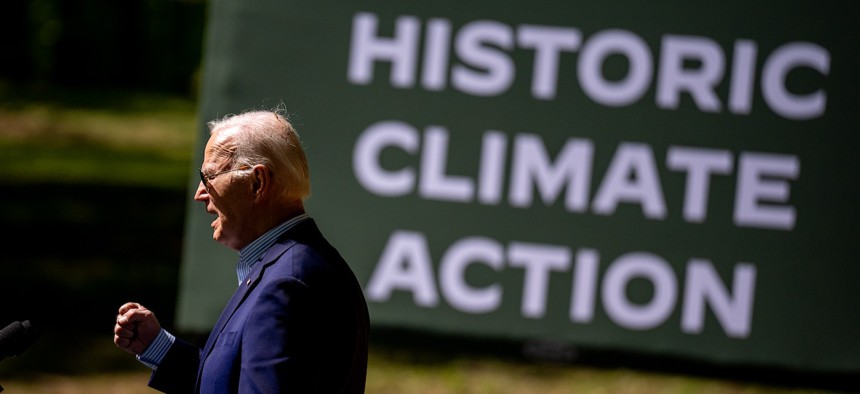
President Biden speaks on Earth Day at Prince William Forest Park on April 22, 2024 in Triangle, Va. Biden announced his American Climate Corps initiative, while commemorating the 54th anniversary of Earth Day, started in 1970 to raise awareness and support for environmental protection. Andrew Harnik/Getty Images
Can Biden’s new jobs program to fight climate change attract women and people of color?
The American Climate Corps program aims to recruit a diverse workforce. But it will face challenges including low pay, the need for child care, and historic discrimination against women in the trades.
Originally published by The 19th
At a national park in Virginia on Monday, President Joe Biden announced that people can start applying to the American Climate Corps, a program that is expected to connect workers with over 20,000 green jobs.
“You’ll get paid to fight climate change, learning how to install those solar panels, fight wildfires, rebuild wetlands, weatherize homes, and so much more that’s going to protect the environment and build a clean energy economy,” Biden said at the Earth Day event.
The American Climate Corps (ACC) is modeled after the Civilian Conservation Corps (CCC), which was created by President Franklin D. Roosevelt in 1933 to employ men in environmental projects on the country’s public lands — projects like trail building, planting trees and soil erosion control. Nearly 3 million people were put to work in an effort to address both Depression-era unemployment and to shore up national infrastructure. But it wasn’t very diverse. Although Black and Native American men were allowed to enroll, the work was segregated. And women could not apply. For a brief time, a sister program created by Eleanor Roosevelt — mockingly called the “She-She-She camps” by its detractors — trained 8,500 women in skills like typing and filing.
The Biden administration is adamant that this iteration of the program will attract a more diverse conservation and climate workforce, promising that the program will “look like America” and expand pathways into the workforce for people from marginalized backgrounds.
On Monday, Biden announced the launch of a long-awaited job board where applicants can look for opportunities. Some positions were created through the American Climate Corps partner agencies like the Forest Service, which announced the Forest Corps — 80 jobs in reforestation and wildfire mitigation — or the USDA’s Working Lands Climate Corps, with 100 positions. At the same time, the Department of Interior and the Department of Energy announced a new project that will place corps members in priority energy communities — places that have historically been the site of coal mining and power plants — for work in community-led projects like environmental remediation. All of these positions have a term limit, although they vary; some listed on the website are seven-months for example, others are over a year long.
Other jobs listed on the site are compiled from existing conservation corps programs; either state-run programs like the California Conservation Corps or those run by nonprofits like Conservation Legacy. These provide opportunities for young people in local communities to do everything from prescribed burning on public lands to solar panel installations on schools.
So far, there are 273 listings on the website, ranging from working on trail crews to invasive plant management to wildland firefighting positions. There is also an “ag literacy” position to teach kids about where their food comes from, and a posting for a climate impact coordinator who will help a Minnesota nonprofit develop climate resilience projects. That’s a far cry from the administration's goal of 20,000 jobs. But supporters of the program say opportunities to expand ACC are endless — from home weatherization positions to planting tree canopies in urban areas. The question is whether these mostly taxpayer-funded jobs will attract and retain a diverse workforce and benefits women and LGBTQ+ workers, as well as people of color.
“We know that it is going to take everybody to solve the climate process and we need to field the whole team. That’s exactly the way we’ve thought about building this program,” said Maggie Thomas, special assistant for climate to Biden.
Because the program is working with The Corps Network, a national association of about 140 conservation groups, there is already some data on how modern-day organizations operate, said Mary Ellen Sprenkel, president and CEO of the network. “They collectively engage almost 25,000 young people a year and are very diverse — young people from urban areas to rural areas. There is a diversity of race, ethnicity, gender, socioeconomic status and education level.”
According to the organization’s data from 2023, the most recent year available, 44% of their members were women and 3% were gender non-conforming or gender expansive. Fifty-nine% identified as White, while 14% were Black, 23% were Latino, 4% were American Indian, 3% were Asian and 2% were Pacific Islander.
Sprenkel sees those numbers as progress. “What has evolved out of the original CCC has naturally become much more diverse in terms of member opportunities. And so building on that for the ACC, I think it will naturally happen,” said Sprenkel.
In addition, any of the jobs created through federal agencies in collaboration with the ACC must adhere to the administration's Justice 40 initiative, which means 40% of the benefits must go to marginalized communities, in this case either through job creation, or through the projects being funded through monies like the Inflation Reduction Act.
One aspect of parity will be how well these jobs pay. Many of the positions listed on the ACC site are funded through AmeriCorps, which pays modest living stipends that have been criticized as “poverty wages.” AmeriCorps “was designed for middle class White people who could get support from their parents to have this opportunity,” Sprenkel said. But the Biden administration wants to ensure that all young people can serve, she continued, not just those who can afford to take lower-paying positions.
Sprenkel said the administration is aiming for positions to pay a living wage — with some wiggle room that allows for lower wages as long as housing and other benefits are provided. “[They’ve] said we would like for programs to strive to pay their members $15 an hour, but if that is the result of a package where you're providing housing and transportation, that's OK.”
One way the administration has aimed to increase pay transparency is to list an hourly wage equivalent for the jobs posted on the ACC website, said Thomas. This number could factor in stipends for transportation, living expenses and educational awards. Many jobs currently listed go above the $15 minimum — though some require more than entry-level experience.
There are also efforts in the works to increase the low stipends of current AmeriCorps members. “The president has called on Congress to raise the minimum living allowance for all of our crew members to at least $15 an hour as a starting point,” said Yasmeen Shaheen-McConnell, senior advisor for AmeriCorps. In the interim, she said, many corps positions have been able to offer packages equivalent to $15 an hour through public and private partnerships with states and outside organizations.
Madeleine Sirois, a research analyst with the left-leaning think tank Urban Institute, has been researching workforce development pathways in the clean energy transition. She said offering paid opportunities to enter a new career is a good starting point. “So many people want to upskill, they want to get new credentials, and maybe change career paths. But then they can't leave their current job that maybe only pays 10 bucks an hour,” she said.
But other benefits are important, too, if the program is going to be equitable in its rollout, said Sirois. “It's been mentioned on the portal that there are health care, child care, transportation and housing available, but it does say only some opportunities will offer that,” she said. “So it leaves me with the question of: Who has access to that and who doesn't?”
Among the initial 273 listings posted on the ACC site, The 19th found only four that listed child care as a benefit, though Shaheen-McConnell said that eventually more of the positions will offer it.
Sirois said another important aspect of the ACC will be whether it will lead to actual jobs in clean energy and climate work after corps service ends. She was heartened by Monday’s announcement that the ACC had partnered with the North America's Building Trades Alliance TradeFutures program, which will provide every ACC member access to a free pre-apprenticeship trades readiness program. Trades jobs make up the foundation of the clean energy transition, but have historically gone to men. Just 4% of women are trades workers in the United States.
“These are all really important, especially for getting women and people of color into these jobs, and apprenticeships that will lead into quality careers that are unionized in many cases. So I think that's fantastic,” said Sirois. However, while the administration has also touted that ACC positions will offer workforce certifications and skill-based training, Sirois said those are only offered for some corps members. Getting clarity on how many of these jobs will lead to improved employment opportunities will be key.
It’s going to take time to see how the program plays out, she said, and learn if it will be successful in placing women and people of color in trades jobs, despite historic discrimination. “When we talk about moving people into jobs, it’s making sure we're very specific about what kinds of jobs in terms of the quality,” she said. “It's about opportunities for advancement, having meaningful work, a workplace free from discrimination and harassment, and feeling that you have a voice on the job.” Sirois hopes the administration will collect data on corps members that tracks completion rates and job placements after service, and that the data can be disaggregated by gender and race.
Thomas said American Climate Corps jobs should be considered the earliest stage of the workforce development pipeline — leading to better paying jobs down the line. “This is an opportunity for young people to take action right now in communities across the country, on climate projects that we know have a tangible impact today.






